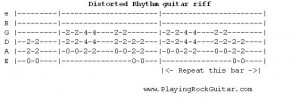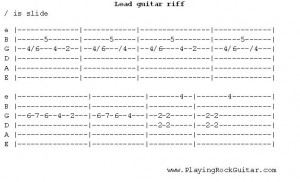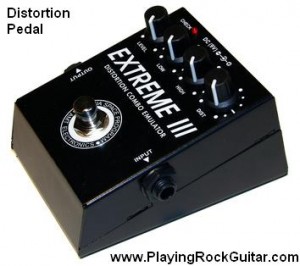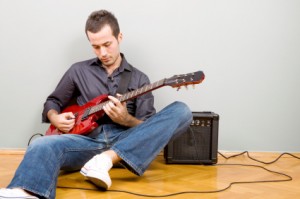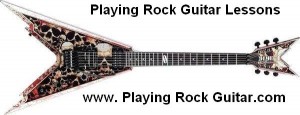Soundcheck for Rock guitar playing
Here are a few guitar tab riffs to test out your sound. You need three sounds for playing rock guitar, distorted rhythm, lead guitar and a clean acoustic sound.
First riff is for a good dirty rock or distorted rhythm guitar sound.
Play this with overdrive and or distortion, either pedals or a push in switch on your amp.
Volume knobs on the guitar and amp can be turned up high. On your amp set your Gain to 4 or 5, Bass and Treble to around 6 and Mid to 4 or 5. (Secret is to have both your bass and treble higher than the mid setting).
You can put the lead for your guitar in to the high impedance input of the your guitar amp or if using pedals in to the low impedance input.
Set your guitar pickup selector switch to use the bridge pickup. The bridge pickup is sharper than the neck pickup and will give a good heavy, sharp, precise sound for rock riffs. This will be your main sound for your guitar lessons.
Rock rhythm guitar is mainly played on the EADG or 3, 4, 5 and 6 strings. This riff is based on two open powerchords (an E and an A powerchord) and a B powerchord.
Second riff tab is for a lead guitar sound.
Play this with any effects that add to the sound you want, overdrive or distortion, chorus, delay, doubler etc. Experiment till you get a sound that you like. Keep the same amp settings as above with the lead for your guitar (high) or pedals (low) in the same impedance input of your guitar amp.
Switch the guitar selector switch to the bridge pickup to get a mellower warm rock sound. You would also want to get a sound with some sustain to the notes, a compressor pedal can help with this.
Lead guitar is usually played on the DGBe or 1, 2, 3 and 4 strings. This is played on the first few strings of the guitar, it is nearly all single string riffs except for the end. Play it slow and slide where indicated in the tab with the symbol /
With the Multi-effect guitar pedals you can set up 3 separate patches. Have one patch for each sound (rhythm, lead and clean) and you can switch quickly and easily between the three sounds as required. For this leave the guitar lead in the low impedance input on your amp the whole time.
In the next part we look at getting a clean acoustic sound in an acoustic guitar lesson.
